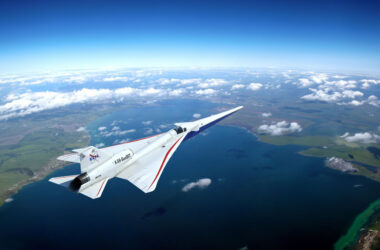We know very little about our atmosphere’s outermost layer, but that is about to change as Engineers are working towards launching 50 mini-satellites to study it.
Engineers from 28 countries, including Europe, Japan, the US, and Australia are working on an international project called QB-50. This will see 50 CubeSats (tiny satellites measuring 10cm on each side, and weighing only 1kg each) launched from the International Space Station (ISS) to study Earths thermosphere.
Subscribe
If you enjoyed this article subscribe to our mailing list to receive weekly updates!
The thermosphere is crucial to us as we rely on it to protect us from cosmic radiation. It exists between 200-380kms above Earth’s surface. The CubeSats will feed back data on how it functions. Once launched from ISS 380km orbit they will drift down the lower regions of the thermosphere
Andrew Dempster, part of the University of New South Wales (UNSW) team explains the thermosphere “is a region poorly understood and hard to measure. And yet, it’s the interface between our planet and space[.] It’s where much of the ultraviolet and X-ray radiation from the Sun collides with Earth, and generates auroras and potential hazards that can affect power grids and communications”
The UNSW team will produce two CubeSats; UNSW-Ec0, INSPIRE-2w. These will study the atomic composition of the thermosphere. A wider joint project between University of Sydney, UNSW, and the Australian National University called INSPIRE-2 will measure the electron temperature and density of plasma in the region.

A render of how the CubeSats will look
As CubeSats are so small they are a lot cheaper to launch than large satellites. This means researchers are able to get a lot more data for their money. However, each satellite will still cost around $750,000 USD to produce.
The launch date is now set for December. The satellites will be sent to ISS on an Orbital ATK Antares rocket from Wallops Island, Virginia then deployed over the next month.
Interested in finding out more about CubeSats?
CubeSats, the type of miniaturised satellite that will be used for this study could revolutionise space science due to their low cost and (comparatively) easy production using off-the-shelf components. Find out more about them in this video by NASAs Jet Propulsion Laboratory.
NASA Jet Propulsion Laboratory – Published Dec 2015
A full list of all 50 CubeSats and their institutions is below. More information of Frequencies can be found @ne.jp
| Satellite | Country | Supporting Organisation |
|---|---|---|
| 14-BISAT | Brasil | Instituto Federal Fluminense |
| Aalto 2 | Finland | Aalto University |
| ANUSAT 2 | India | Anna University |
| Aoxiang 1 | China | Shaanxi Engineering Laboratory for Microsatellites |
| BeEagleSat | Turkey | Istanbul Technical University |
| BUSAT 1 | China | School of Astronautics – Beihang University |
| DelFFi-Delta/Phi | Netherlands | Delft University of Technology |
| DeltaDsat | UK | Cranfield University |
| DragSail-CubeSat | Germany | FH Aachen University of Applied Sciences |
| DUTHSAT | Greece | Democritus University of Thrace |
| EntrySat | France | ISAE Institut Superieur de l’Aeronautique et de l’Espace |
| ExAlta 1 | Canada | University of Alberta |
| GAMASAT | Portugal | Faculty of Engineering of the University of Porto |
| HAVELSAT | Turkey | Havelsan & Istanbul Technical University |
| Hoopoe | Israel | Herzliya Science Center |
| i-INSPIRE II | Australia | University of Sydney |
| InflateSail | UK | Surrey Space Centre |
| KPI-SAU 1 | Ukraine | National Technical University of Ukraine – Kiev Polytechnic Institute |
| LilacSat 1 | China | Harbin Institute of Technology |
| LINK | Korea | Korea Advanced Institute of Science and Technology |
| LituanicaSAT 2 | Lithuania | NPO Innovative Engineering Projects |
| Nano-JASMINE | Japan | University of Tokyo |
| NJUST 1 | China | Nanjing University of Science and Technology |
| NUDTSat | China | National University of Defense Technology |
| OGMS-SA | France | Universite Paris-Est Creteil |
| Pegasus | Germany | Fachhochschule Wiener Neustadt |
| PHOENIX | Taiwan | National Cheng Kung University |
| PICASSO | Belgium | Belgian Institute of Space Aeronomy |
| QARMAN | Belgium | Von Karmin Institute for Fluid Dynamics |
| QB-Colombia | Colombia | Universidad Distrital Francisco Jose de Caldas |
| QBITO | Spain | Universidad Politecnica de Madrid |
| QBUS 1 | USA | University of Colorado Boulder |
| QBUS 2 | USA | University of Michigan |
| QBUS 3 | USA | Stanford University |
| QBUS 4 | USA | Universidad del Turabo |
| RIOSAT | Austria | Graz University of Technology |
| RoBiSAT 1/2 | Romania | Institute of Space Science |
| SamSat | Russia | Samara State Aerospace University |
| SAT_IP2 | France | INSSET Institut superieur des sciences et techniques |
| SIMBA | Belgium | Royal Meteorological Institute |
| SNUSAT 1 | South Korea | Seoul National University |
| SOMP2 | Germany | DresdenTechnische University |
| SpaceCube | France | Mines Paristech |
| STU 1 | China | ShanghaiTech University |
| SUSat | Australia | University of Adelaide |
| UCLSat | UK | MSSL University College London |
| UNSW-EC0 | Australia | University of New South Wales |
| UPSat | Greece | University of Patras |
| URSA MAJOR | Italy | University of Rome |
| VZLUsat 1 | Tschechien | Aerospace Research and Test Establishment |
| X-CubeSat | France | Ecole Polytechnique |
| YUsend-QB50 | Kanada | York University Toronto |
| ZA-AeroSat | South Africa | Stellenbosch University |
| ZJU CubeSat | China | Zhejiang-Universitat |








